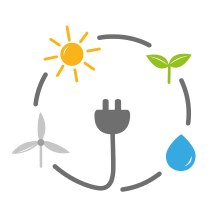
Did you know that converting your home into an energy-efficient environment saves money on monthly service bills as well as taxes? If you renovated your home or are planning to do so, have a look at these energy tax credits! They will provide you with some tax relief, helping you to save plenty of money in more ways than one! Do you want to change the windows in your house to save on heating and cooling costs? You can do so by making it energy efficient with a tax credit for 10 % of the total cost. This is $200 per window and $500 per door or skylight. It doesn’t matter how many you would like to be replaced. There is no labor charge included – only the price of the specific items. To claim the credit, they are required to be EnergyStar rated. Not only will you save on your monthly energy bills, you can get some tax relief as well!
Taking advantage of green DIY energy in today’s energy climate is more important than ever as fossil fuel resources slowly begin to dwindle and the need for new “green” technologies becomes ever more crucial. Do-it-yourself (DIY) green projects can be a great way to get started on making the shift from fossil fuel consumption to energy sources that are friendly to the environment, for one. If anybody needs any convincing that maybe completing a few do-it-yourself green energy conservation projects should be the way to go, consider that an average family uses a comparatively large amount of energy at any given time. As well, consider that most of that energy is delivered from power plants that make use of oil, natural gas or coal, which is especially dirty in most circumstances. People can start on their own do-it-yourself “greening” simply by searching the Internet for a wide variety of resources, including plans for making their own personal wind turbine energy generation units (many can be made for less than $100) and also a fair number of do-it-yourself plans for building their own solar panels, as a matter of fact.
A green energy home is an energy efficient home, usually utilizing renewable energy sources from the sun and wind. These resources can provide hot water and electricity for the home’s needs. The advancements in techniques have made things available that were never within the financial reach of Joe Six Pack before. There is an awaking to alternative energy sources and using them to reduce electrical bills and the carbon foot print. More and more folks are opting to cut their apron strings to the utility companies in favor of saving the planet. They are using technologies like green energy power sources. Technology is now available to buy all the necessary bits and pieces needed to self construct your own energy creating devices. These devices include wind power or windmills and solar panels to create the electricity for the green energy home. A savvy home owner can also use passive solar energy for the heating of water and heating his home during the winter months. If a body knows the difference between a screwdriver and a hammer, they can build their own solar panels and windmills at a fraction of the cost of purchasing them ready-made.
With increasing price of crude oil and as the level of air pollution increases the best way to conserve energy and protect the environment is to go for a green energy home. If you are constructing a new house, then this is the best time to implement green technology. You can implement a green energy home project in several ways. One of the easiest ways to start is by installing solar energy system at home. You can install solar energy based water heaters instead of electricity based water heaters. Another excellent option is to install solar panels that use photovoltaic cells to generate electricity from the rays of the sun. This system can be easily built at home using step-by-step guides that can be purchased from Internet. The feasibility of a solar energy based project will depend of the availability of sunlight throughout the year. You will also require space on your rooftop that has no obstructing trees and buildings in the near vicinity.
The Butterfly Effect, a phrase coined by Edward Lorenz, derives its name from a theoretical example of a hurricane’s formation being based on whether or not a distant butterfly had flapped its wings several weeks earlier. Though this may sound esoteric and even nonsensical to some, this phenomenon is apparent in many simple systems and, interestingly, it can easily be demonstrated in standard weather prediction models. Consider that a small pebble dropped in the middle of a lake will produce a series of ripples that grow in all directions from the size of the pebble to reach every inch of the lakeshore. A toy sailboat, in fact, may be run aground from these ripples – which were set in motion, in a sense, by a tiny pebble on the other side of the lake. Lorenz once said that one meteorologist remarked, “If this theory is correct, the flap of a seagull’s wings could change the course of weather forever.” If a butterfly in Brazil can set off a tornado in Texas, as the title of one of Lorenz’s talks suggests, what effect will several thousand monstrous, 400-foot tall windmills have?
